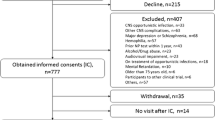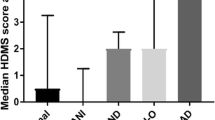Abstract
The prevalence of HIV-associated neurocognitive disorder (HAND) remains persistently high in the era of combination antiretroviral therapy. We aimed to characterize the pattern of neurocognitive dysfunction in older subjects with HAND in particular amnestic versus non-amnestic impairment. One hundred six subjects from the Johns Hopkins University NIMH Clinical Outcomes cohort underwent standardized neuropsychological (NP) testing between November 2006 and June 2010. We examined performance in seven cognitive domains (memory, attention, speed of processing, visuospatial, language, motor, and executive). Older subjects were defined as age >50 years at the time of NP testing. Subjects were diagnosed with HAND according to established criteria and dichotomized into amnestic cognitive impairment or non-amnestic cognitive impairment with deficit defined as z scores <−1.5 for the verbal and nonverbal memory domains. There were 32 older subjects with a mean age (SD) of 54.2 (2.8) years and 74 younger subjects, 43.7 (4.3) years. Older age was associated with a 4.8-fold higher odds of memory deficits adjusted for potential confounders (p = 0.035) identified a priori. With age modeled as a continuous covariate, every 1 year increase in age was associated with a 1.11-fold higher odds of memory deficit (p = 0.05). There was a higher proportion of amnestic cognitive impairment among older subjects than younger subjects with HIV infection. Neurodegenerative processes other than those directly due to HIV may be increasingly important as individuals with chronic HIV infection and HAND survive into older age.
Similar content being viewed by others
References
Bowie CR, Harvey PD (2006) Administration and interpretation of the Trail Making Test. Nat Protoc 1:2277–2281
Brew BJ, Cysique LA (2010) Alzheimer disease and HIV: a tangled story. Neurology 75:105–106
Concha M, Selnes OA, McArthur JC et al (1995) Normative data for a brief neuropsychologic test battery in a cohort of injecting drug users. Int J Addict 30:823–841
Cysique LA, Maruff P, Brew BJ (2004) Prevalence and pattern of neuropsychological impairment in human immunodeficiency virus-infected/acquired immunodeficiency syndrome (HIV/AIDS) patients across pre- and post-highly active antiretroviral therapy eras: a combined study of two cohorts. J Neurovirol 10:350–357
Esiri MM, Biddolph SC, Morris CS (1998) Prevalence of Alzheimer plaques in AIDS. J Neurol Neurosurg Psychiatry 65:29–33
Green DA, Masliah E, Vinters HV et al (2005) Brain deposition of beta-amyloid is a common pathologic feature in HIV positive patients. AIDS 19:407–411
McArthur JC, Steiner J, Sacktor N, Nath A (2010) Human immunodeficiency virus-associated neurocognitive disorders: mind the gap. Ann Neurol 67:699–714
Roberts RO, Geda YE, Knopman DS et al (2008) The Mayo Clinic Study of Aging: design and sampling, participation, baseline measures and sample characteristics. Neuroepidemiology 30:58–69
Rountree SD, Waring SC, Chan WC et al (2007) Importance of subtle amnestic and nonamnestic deficits in mild cognitive impairment: prognosis and conversion to dementia. Dement Geriatr Cogn Disord 24:476–482
Sacktor N, McDermott MP, Marder K et al (2002) HIV-associated cognitive impairment before and after the advent of combination therapy. J Neurovirol 8:136–142
Sacktor N, Skolasky R, Selnes OA et al (2007) Neuropsychological test profile differences between young and old human immunodeficiency virus-positive individuals. J Neurovirol 13:203–209
Shin MS, Park SY, Park SR et al (2006) Clinical and empirical applications of the Rey-Osterrieth Complex Figure Test. Nat Protoc 1:892–899
Strauss E, Wada J, Goldwater B (1992) Sex differences in interhemispheric reorganization of speech. Neuropsychologia 30:353–359
Tan CS, Koralnik IJ (2010) Progressive multifocal leukoencephalopathy and other disorders caused by JC virus: clinical features and pathogenesis. Lancet Neurol 9:425–437
Tan IL, McArthur JC (2011) HIV-associated central nervous system diseases in the era of combination antiretroviral therapy. Eur J Neurol 18:371–372
Tanyolac S, Mahley RW, Hodoglugil U, Goldfine ID (2008) Gender differences in the relationship of ENPP1/PC-1 variants to obesity in a Turkish population. Obesity (Silver Spring) 16:2468–2471
Unverzagt FW, Gao S, Baiyewu O et al (2001) Prevalence of cognitive impairment: data from the Indianapolis Study of Health and Aging. Neurology 57:1655–1662
Valcour VG, Shikuma CM, Watters MR, Sacktor NC (2004) Cognitive impairment in older HIV-1-seropositive individuals: prevalence and potential mechanisms. AIDS 18(Suppl 1):S79–86
Conflict of interest
Ik Lin Tan, Bryan R Smith, Edward Hammond, H Vornbrock-Roosa, Jason Creighton, Ola A. Selnes, and Ned Sacktor have no conflicts of interest. Justin C McArthur received grants from NIH, Biogen-Idec, payment from lectures, speaker bureau in various universities, book royalties, and stock option from Gliamed.
Author information
Authors and Affiliations
Corresponding author
Rights and permissions
About this article
Cite this article
Tan, I.L., Smith, B.R., Hammond, E. et al. Older individuals with HIV infection have greater memory deficits than younger individuals. J. Neurovirol. 19, 531–536 (2013). https://doi.org/10.1007/s13365-013-0209-3
Received:
Revised:
Accepted:
Published:
Issue Date:
DOI: https://doi.org/10.1007/s13365-013-0209-3




